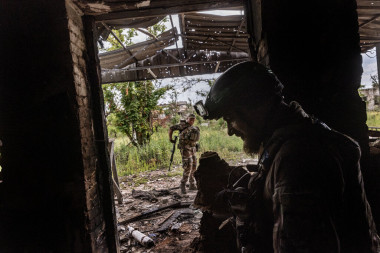In Small Victory, Signs of Grueling Combat Ahead in Ukrainian Counteroffensive
Submission Statement
In addition to being just a genuinely excellent work of journalism, this article possesses both tactical and strategic insights into the war in Ukraine. Tactically speaking, this article is a soft acknowledgment that, despite armored vehicle aid being provided by the West, Ukraine continues to make heavy use of dismounted infantry and small-unit tactics. I’m skeptical of the article’s claim that this was intended to keep the movement low profile–judging by the description of the defenses, even a small amount of armor would have been massively helpful in clearing the village quickly. Rather, this is likely a function of limited stockpiles of such vehicles and emphasizes the need for greater mobility aid to be donated by Western partners. Another point of interest is the coordination of soldiers and artillery by drone operators. The operators were the link between soldiers on the ground and their artillery support. Drones and drone operations as the nerve center of the Ukrainian offensive have been mentioned before but I found it interesting that the description given here implies that drones are the key to Ukraine’s flexible and responsive reconnaissance/fires complex.
Another tactic mentioned here is artillery-based demining operations. Specifically, the article describes the (probably unguided) artillery barrage as being intended to destroy mines scattered around the outside of the village. While this makes intuitive sense(the pressure from the blast should detonate mines within a certain radius of the shell’s impact) I had not heard of this tactic before. On the subreddit, there was a recent question about the feasibility of artillery-based demining and users seemed skeptical of its efficacy. From the way the article describes it, the tactic is at least plausible enough that the Ukrainians attempted it here.
Strategically speaking, the forces described here are interesting. 70 Ukrainian TDF soldiers(plus 20 or so reinforcements) vs. 150 Russians and an unknown number of Storm Z. First off, this is further confirmation that TDF has been mostly subsumed into the broader military structure as opposed to being linked to their home territories. Secondly, the Ukrainians were apparently told to expect 20 or so enemies. It’s a major ISR failure that troops walked into a force concentration 10 times that. By all rights, this battle should have been a bloody failure, and I wouldn’t be surprised if there are other villages where that was the case. As it was, the attack was stopped in its tracks until developments on the front nearby forced the Russians to leave their position. Tactical intelligence sharing would be massively helpful in these cases. I have no doubt that US ELINT and SATINT would have been more than capable of accurately assessing the force concentrations in the area. It’s a low-cost, low-profile intervention that would save Ukrainian lives and enable their offensive operations massively. Frankly, I’m a bit mystified that it’s not happening already. Third, this is another blow against the idea that the victories of this counteroffensive are happening in the “grey zone” of the Russian occupation. The Russians are clearly deploying their troops forward of their entrenchments and fighting for every inch of land. That might(emphasis on “might”) mean that Ukraine has an easier task ahead of it than those red-line maps imply.
A final, extremely speculative note: the casualty assessment reported here is positive for Ukraine. More than 12 Russian casualties vs. probably about 24 or so Ukrainian casualties (6 dead, 1:3 KIA/WIA ratio) implies that Ukrainians are overperforming the assumption that the attacker takes 3 times as many casualties as the defender. Obviously, this is very speculative. Casualty estimates are always unreliable, especially when talking about such a tiny sliver of the battlefield. There are certainly areas where the ratio is equally lopsided in favor of the Russians. But it’s an interesting data point that I wanted to at least mention.
These aren’t all the takeaways. I strongly recommend reading through the article as a whole.
The Ukrainian soldiers thought the Russians would quickly retreat from Neskuchne, a tiny village in southern Ukraine, especially after a concerted artillery barrage and a rocket strike on their headquarters.
Instead, the Russians dug in, fighting for two days before giving up the village last month, leaving their dead decaying on the roadside and piles of expended ammunition around their makeshift defenses.
The Russian defeat, on June 9, was Ukraine’s first win in a prolonged counteroffensive that is well into its fourth week but moving at a slower pace than expected. In that respect, the battle for Neskuchne served as an early warning that Kyiv’s and the Western allies’ hopes for a quick victory were unrealistic and that every mile of their drive into Russian-occupied territory would be grueling and contested.

Add comment